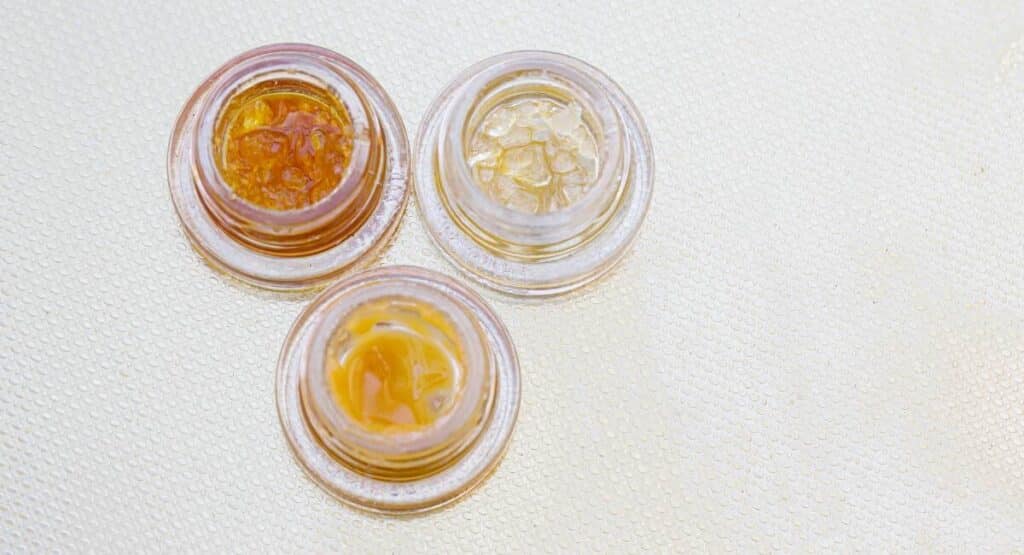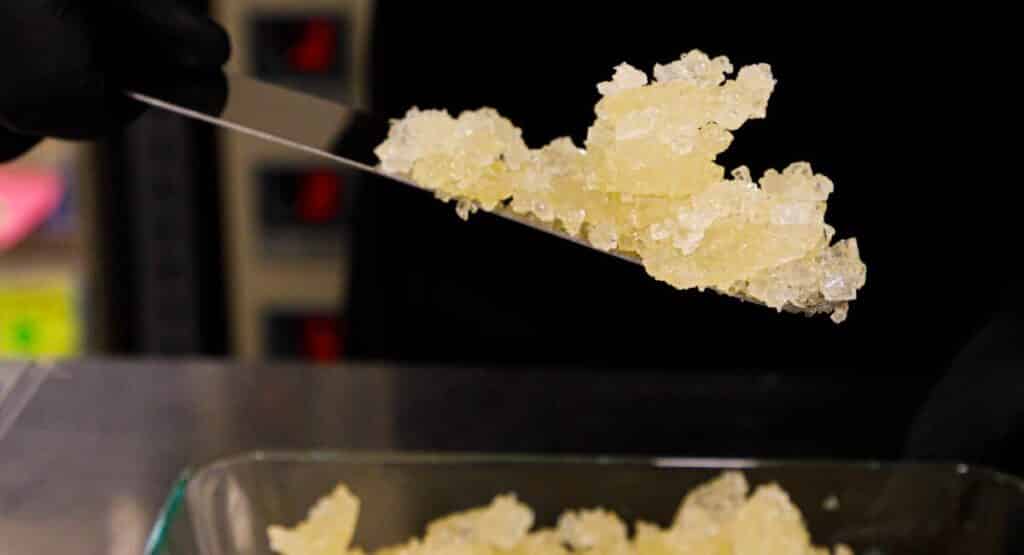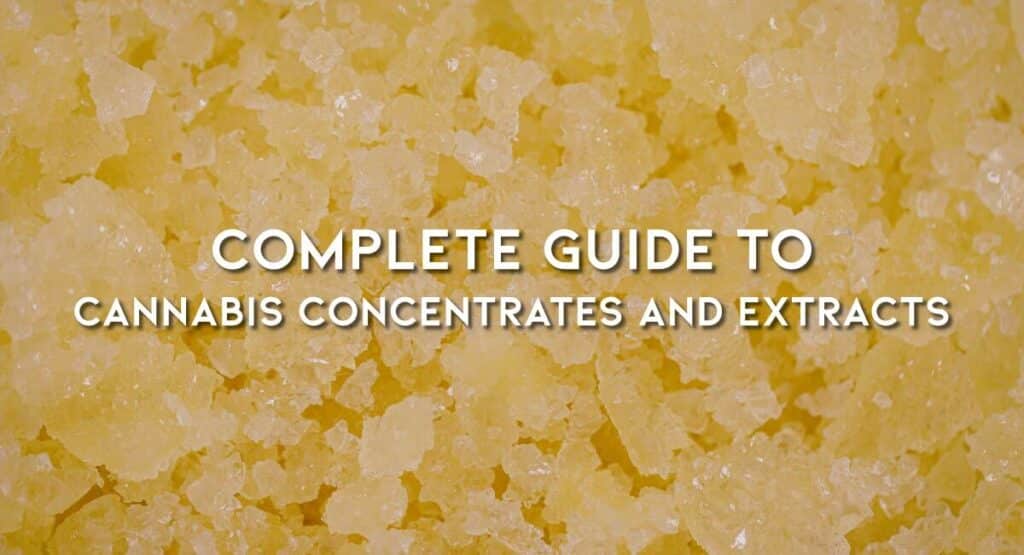Over the years (and decades, really), the art of cannabis extraction and concentration has evolved into a massive market segment. There are tons of textures and flavors, with varying degrees of terpene and cannabinoid profiles to intrigue your taste buds and give you the utmost high. If you want to learn more about the various types of cannabis concentrates and extracts—including the difference between the two—this guide is for you.
Difference Between Concentrates vs Extracts
Concentrates and extracts are both used to describe a highly potent form of cannabis oil. You might see the term concentrates used more often as an umbrella term for all these formats. However, the two have some primary differences; the names are the biggest clue.
A cannabis concentrate is precisely that—a concentrated version of cannabis. The process begins with fresh or dried cannabis buds, and there are many methods for concentration. Some call for ice and water, and others call for simply heat and pressure. However, there is one common thread for cannabis concentrates—they do not require the use of any solvents. The end result is a concentrated product that tastes remarkably similar to the fresh cannabis plant.
Quite the opposite is true for cannabis extracts. Rather than concentrating the plant, a solvent is used to extract the valuable compounds in cannabis. Specialized extraction equipment washes the plant material with a solvent like butane or propane and pulls out the terpenes and cannabinoids. Then, the raw oil is placed into a vacuum chamber where any residual solvents are purged. A lot of magic happens here in post-processing that determines what the final product looks like and tastes like.
Types of Concentrates

Concentrates are defined by their solventless production. Each of these could potentially be made at home, although the best concentrates are made by experts that have practiced the craft for many years. While ingoing material is always essential for concentrates or extracts, it’s especially important for concentrates. If you use fresh, big buds, you will get much better results than if you use trim or old, dried buds.
Bubble Hash
Bubble hash is the OG of all cannabis concentrates. This stuff has been around longer than we know, and honestly, it holds up. Also known as ice wax, water hash, or ice water hash, bubble is a full-melt cannabis concentrate. You can top it on a bowl, roll it up into a joint, or simply smoke it as is.
Bubble hash is made by agitating cannabis buds in icy water with the help of a fine mesh sieve. There are special bubble bags for this process that help you collect the trichome heads that separate from the buds. The end product is dark to light brown, sometimes even a light golden color. It tastes deep, earthy, and rich. Bubble hash offers an incredible high that is much stronger than the originating flower.
Dry Sift
Dry sift is similar to kief in appearance except it is full melt and much lighter in color. You’ve probably collected kief yourself, it’s what remains at the bottom of your weed jar or bag and consists of dried trichomes that have fallen off the buds. Most grinders contain a chamber that collects kief every time you grind up a nug. However, making dry sift is a much more involved and tedious process that yields a full melt concentrate that would be insulting to the maker, plant, and product itself to call kief.
This is most commonly done by using box screens that gradually get smaller in microns to filter out all the plant matter leaving just the trichomes in the final stage. This is much more than simple kief produced in a grinder’s catch. A properly done dry sift will rival your full melt bubble hashes, a standard that kief can’t touch . Since much of the terpene and cannabinoid content is found in the trichomes, this is like taking a super potent puff of the most active part of a cannabis plant.
Rosin
Rosin is one of the purest, most delicious forms of cannabis concentrate. It’s made with a manual or hydraulic press that essentially squeezes buds with heat and literal tons of pressure until the resinous sap comes out. First, you place buds between pieces of parchment paper or inside a rosin bag. Then, you put it between two hot steel plates and squeeze firmly. A golden oil begins to emerge with the right amount of pressure and perfect heat.
Use freshly harvested flowers that have been flash frozen and turned into bubble hash if you want an even more flavorful version of rosin. These extra steps make live rosin, and it’s bursting with fresh cannabis flavor by way of its wonderfully preserved terpene content. You can dab it (best and recommended option given its premium price point), roll it into a joint, or top a bowl, and it will add an incredibly bright flavor and ultra-luxe high to your smoking experience.
Types of Extracts

The science behind cannabis extracts is fairly complex. It’s not safe to do at home and requires the use of a closed-loop extraction machine and several other pieces of equipment. This is the only way to ensure a clean, safe product. Although there are various hydrocarbons used to make extracts, the real differences come through in the end result. There are so many textures, consistencies, and colors to marvel at when comparing the different types of extracts.
Live Resin
The starting material is the main difference between live resin and other extracts. Instead of dried flower or trimmings, live resin is exclusively made with freshly harvested cannabis. Sometimes the fresh cut buds are processed right away, but most of the time, they are flash frozen and stored in a freezer until extraction time.
The purpose of this process is to preserve the trichomes that often fall off (hello, kief). The resulting extract is like sipping a fresh fruit smoothie, overflowing with flavor and aroma that mimics the fresh plant itself. Because the terpene content remains largely unchanged, the entourage effect is in full force, producing a full body high that lasts for hours. Live resin is marigold, amber, or deep orange and requires a dab tool
Shatter
Shatter got its name from its sheetlike appearance that can shatter into pieces when dropped. It’s much more brittle than other extracts and sometimes looks like Swiss cheese, with holes that popped during the vacuum purging process.
It’s typically golden to translucent and highly potent. However, shatter often loses a lot of terpene content during extraction, so it isn’t as full-bodied as live resin. Nor does it have as much flavor. It’s not uncommon to see THC percentages upwards of 85% in some shatters.
Budder
Budder is made much like shatter—usually with butane, propane, or a mix of both. Typically, buds and trimmings go in, and the magic happens in post-processing as the oil is whipped into a buttery-like consistency.
Budder is delightfully golden and makes for a tasty dab. You may be tempted to spread it on toast, but be warned, it typically contains a fair amount of THC.
Diamonds
THC diamonds are made by extracting live resin in cold temperatures. Then, applying pressure to the oil with a chromatography machine forms crystalline structures. The crystals are THCa, and once decarboxylated, you essentially have the Everclear of cannabis. Yet, because it’s created from live resin, it maintains a rich terpene content.
Diamonds are one of the most effective ways to maintain the plant’s integrity, harnessing the true power of the cannabinoid and terpene profiles in harmony. The diamonds themselves look a bit like actual diamonds and make for a potent dab. However, you can also liquify them into vape pens.
Crumble
Crumble begins with the same process as shatter and budder. However, in post-processing, the oil is whipped before entering a lower temperature oven. This low and slow purging process creates a crumbly, almost sand-like texture. Its color is anywhere from blonde to deep orange, and you will need a dab tool to scoop it up.
The lower temperatures help preserve terpenes, so the flavor is often better in crumble than shatter or budder.
Wax
Wax, also known as sugar wax, is another extract named for its texture. It’s not quite crumbly, but it’s neither saucy nor buttery. Instead, it’s like the sugar crystals that collect in the bottom of a honey jar. It’s also just as sticky, so be sure to use a tool to handle wax.
It’s made like crumble, budder, and shatter but requires a specific stirring method to get the soft, malleable texture it’s known for. Sugar Wax has a reasonably high cannabinoid content, and the process does preserve some terpenes, but not quite like a live resin.
How to Shop For the Best Concentrates & Extracts
When shopping for concentrates and extracts, look to the source. Where was the flower grown? What was the soil like? Were the plants sun-grown, with only organic nutrients? So often, too much emphasis is placed on the THC percentage or some other seemingly important factor. Yet, premium concentrates and extracts always start with the plant.
At URSA, we work with legacy farmers from Humboldt County. The unique terroir and optimal microclimates provide the most incredible cannabis on the planet. Yep, we said it. It’s the absolute best. Every next step, from harvest to extraction, is carefully calculated to preserve the hard work of each of the growers we work with. Shop our cartridges and concentrates and see for yourself why Humboldt grows the best weed in the world.




